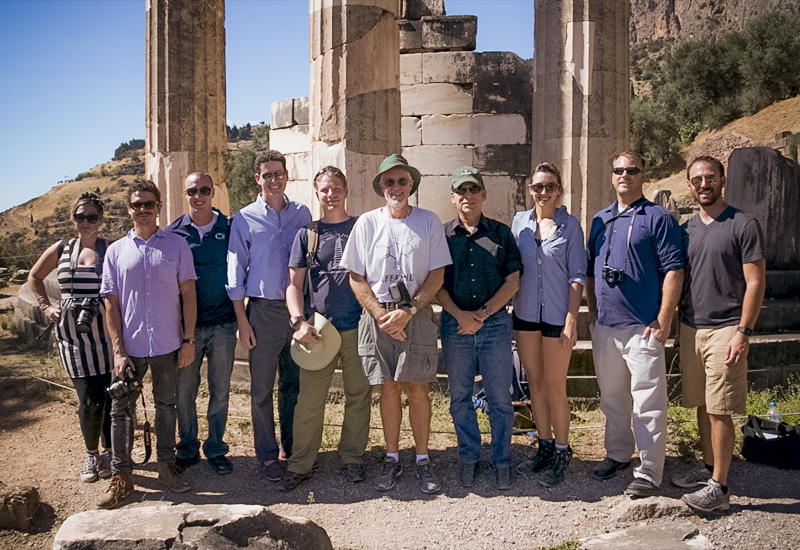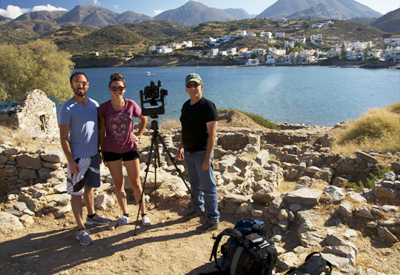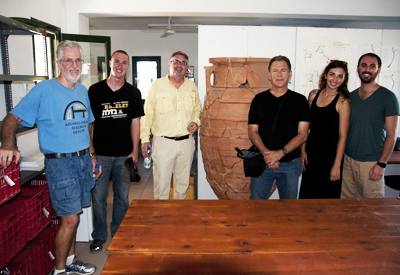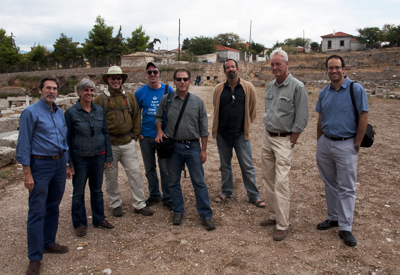Scientists Discover a New Signaling Pathway and Design a Novel Drug for Liver Fibrosis
Health & Behavior
Students from the University of California, San Diego who are part of a National Science Foundation graduate training program in cultural heritage diagnostics spent part of October in the cradle of Western civilization – ancient Greece.
The NSF Integrative Graduate Education and Research Traineeship (IGERT) program gave students a two-month opportunity to participate in field projects at historic sites around the Mediterranean, while also getting experience presenting their research results at high-level conferences for researchers working at the intersection of technology and cultural heritage.

At the Tholos (Round Temple) in Delphi, the team from UC San Diego's Qualcomm Institute included (l-r): Ashley Richter, Vid Petrovic, Matt Howland, Aaron Gidding, Matt Vincent, Steve Savage (Arizona State), Tom Levy, Aliya Hoff, alumnus Neil Smith (now at KAUST), and David Vanoni.
Students on fellowships from the IGERT Training, Research and Education in Engineering for Cultural Heritage Diagnostics (TEECH) project are also part of the Center of Interdisciplinary Science for Art, Architecture and Archaeology (CISA3), based in Calit2’s Qualcomm Institute at UC San Diego.
Thomas Levy, Associate Director of CISA3 and Director of the Levantine Archaeology Laboratory at UCSD, was invited to organize two sessions at the first International Workshop on Virtual Archaeology, Museums, and Cultural Tourism (VAMCT). The meeting took place Sept. 25-28 under the auspices of the Hellenic Ministry of Culture and Sports. It was organized by professors from the University of the Aegean (Ioannis Liritzis), Duke University (Maurizio Forte), and the ATHENA Research Center (George Pavlides).
“The CISA3 team presented two special sessions that captured major thrusts of our research programs in cultural heritage,” said Falko Kuester, Director of CISA3, Associate Professor of Structural Engineering and Calit2 Professor for Visualization and Virtual Reality in UCSD’s Qualcomm Institute. “One session focused on the digital collection of archaeological data in the field, while the second explored advanced methods for visualizing these rich data collections, creating a new ’Big Data’ challenge. I’m grateful that the Institute for Aegean Prehistory awarded Tom Levy a travel grant that facilitated bringing our non-IGERT students and associates to Greece as well, not only for the Delphi conference, but also for two other workshops that took place during their trip.”
Added Levy: “I’m especially interested in fostering collaboration for our students and faculty with colleagues in the eastern Mediterranean region, which has such close cultural and historical ties to the southern Levant – Israel, the Palestinian territories, and Jordan – where our lab has been excavating for decades.”

At Bronze Age site of Mochlos in Crete (l-r): CSE graduate student David Vanoni, anthropology undergraduate Aliya Hoff, and CISA3 Associate Director Tom Levy (with CAVEcam system on tripod).
The first session showcased five presentations by faculty, staff and graduate student researchers, primarily by archaeologists drawing on research results from the 2012 IGERT-TEECH field season, which took place mainly at dig sites in southern Jordan.
CISA3’s Levy, who holds the Norma Kershaw Chair in the Archaeology of Ancient Israel and Neighboring Lands and is a Distinguished Professor in the UC San Diego Department of Anthropology, led the roster of UCSD speakers. His talk on “Transdisciplinary Research and Cyber-Archaeology Today: Toward the Museum of the Future” underscored the growing range of technologies being deployed at the Jordanian dig sites, including aerial balloon imaging, LiDAR laser scanning, and more.
A longtime Levy collaborator, former grad student and postdoctoral researcher in the Qualcomm Institute, UC San Diego alumnus Neil Smith (Ph.D. ’09), delivered a talk on “ArchField: A Digital Application for Real-Time Acquisition and Dissemination – From the Field to the Virtual Museum.” Smith, who is now a research scientist at the Geometric Modeling and Scientific Visualization Center of the King Abdullah University of Science and Technology (KAUST) in Saudi Arabia, described the development and use of the ArchField system for annotating data as it is being excavated.
The three other presentations were delivered by IGERT-TEECH Ph.D. students in anthropological archaeology at UC San Diego, each topic arising from their respective doctoral research programs:
The second UC San Diego session in Delphi centered on the creation and development of visualization systems for archaeological data, notably for collaborative analysis and dissemination to the public through museums and other cultural outreach. “I was especially impressed how our UCSD cyber-archaeology work dove-tailed with the work being carried out by our colleagues at University of the Aegean, Duke University, and the ATHENA Research Center,”said Levy.
Three of the presentations relating to computer science included:

Visiting the pottery lab at the INSTAP Study Center for East Crete with Tom Brogan, Director (in yellow); (l-r) Steve Savage, ASU; Matt Howland, UCSD; Brogan; Tom Levy, Aliya Hoff, and David Vanoni, all UCSD.
More information about CISA3 research and complete citations to related research papers can be found at http://igert.ucsd.edu/igert-teech/publications.php.
Adjunct Professor Stephen H. Savage of Arizona State University – a longtime collaborator of Tom Levy’s Levantine Archaeology Laboratory – described ongoing work on MedArchNet, the Mediterranean Archaeological Network. They developed the MedArchNet as a cyber-infrastructure for archaeological research and heritage management as a digital repository for archaeological data that enables archival digitization of settlement pattern data, facilitates data sharing for quantitative comparison, and works toward open access and collaboration among archaeologists from different regions.
Aliya Hoff, an undergraduate student in bioanthropology who is working on material from professor Levy’s excavations in Jordan with Mohammad Najjar, presented a paper on “Skeletons as Storytellers: Piecing Together the Past from the Field to the Museum.” Hoff leads the CISA3 Undergraduate Research Innovation Internship (CURII) program, and she worked with computer scientists to create visualization methodologies for handling “layered realities,” particularly in the context of skeletal assemblages and workflows of mortuary archaeology. “Our goal,” said Hoff, “is to make it possible for archaeologists and bioanthropologists to begin using their field data much faster for analysis, and to provide more in-depth, ethically accessible information for public dissemination of skeletal remains in museums.” According to Levy, “Aliya’s paper resonated in particular with Dr. Maria Roussou, a keynote speaker and Founding Director of Makebelieve Design and Consulting, Athens.” Roussou is a former graduate student of Tom DeFanti, Senior Research Scientist in the Qualcomm Institute, who leads its scientific visualization laboratories in San Diego and is an emeritus Distinguished Professor in Computer Science from the University of Illinois at Chicago. Roussou spoke about “A vision of adaptive cultural experiences through the use of interactive storytelling in museums” based on her work at the Acropolis Museum.”
Ph.D. student Ashley M. Richter delivered an archaeological theory paper on the social impacts of data access and navigation to information about the past through modern technologies for cultural heritage. Richter is an anthropological archaeology Ph.D. student whose paper aimed at “Finding Meaning in the Data Avalanche: The Ethical Dangers and Community Value of Digitizing the Past.” She explored what the technologies for “layered realities” – as spelled out in the talks by Petrovic, Vanoni and Hoff – might mean for the future of “citizen science” as the past becomes increasingly democratized.

The UC San Diego team spent a day in Corinth with excavation director Guy Sanders (second from right). Pictured (l-r): Jim Wright, Director of the American School of Classical Studies Athens (ASCSA); Ioulia Tzonou-Herbst, Corinth Excavations; Matt Vincent, UCSD; Matt Howland, UCSD; Tom Levy, UCSD; James Herbst, Corinth Excavations; Guy Sanders, Director, Corinth Excavations; Nicholas Blackwell, Assistant Director, ASCSA.
Following the Delphi conference, Levy led grad students Vincent, Howland, Vanoni undergraduate Hoff, as well as Arizona State’s Steve Savage to participate in two additional workshops. The main program was organized by James Wright, Professor and Director of the American School of Classical Studies Athens (ASCSA). This was a full-day event with American, Greek, and European scholars who work in association with the ASCSA. The ASCSA was founded in 1881 by a consortium of nine American universities. It was the first American overseas research center and now the largest, along with the American Academy in Rome. The School began excavations in ancient Corinth in 1896 and the site is one of the oldest continuing excavations in the world. Jim Wright led Levy’s team to Corinth, where they were honored to work with excavation director Dr. Guy D.R. Sanders for a day in applying Structure-for-Motion (SfM) 3D modeling and CAVEcam photography at the Fountain of Peirene – mentioned by the Greek historian Pausanias and, according to Greek mythology, a favorite watering hole of the winged horse, Pegasus.
The other workshop took place on the island of Crete, led by Dr. Thomas Brogan, Director of the Institute for Aegean Prehistory (INSTAP) in East Crete. While on the island, the team was honored to meet the long-term excavator of the Minoan Bronze age island site of Mochlos, Professor Jeff Soles, from the University of North Carolina, Greensboro. Soles directed the team’s application of SfM in the ‘House of the Metal Merchant.’
Following their visit to INSTAP and sites in Crete, the UCSD team wound up their time in Greece by presenting papers at a one-day workshop on Cyber-archaeology organized by ASCSA director, Jim Wright in the School's Cotsen auditorium. According to Levy, "The workshop at the American School in Athens provided a unique opportunity for our UCSD team to share with their colleagues in Greece the integrated data capture, curation, analyses, and dissemination cyber-archaeology system that they developed in Jordan's Faynan district." The ASCSA has developed comprehensive, online excavation databases for their 100-plus-years-old excavations at the Athenian Agora and ancient Corinth, which continue to produce masses of data that require sophisticated databasing. Bruce Hartzler, the School's Information Technology Specialist, presented an overview of their system that dovetails in many ways with the UCSD team. Reinhart Förtsch, Professor at the Deutsches Archaeologisches Institut, commented on the session and provided insights into different European initiatives in archaeology and information technology. The evening ended in a traditional Athenian taverna.
“Our students did an amazing job of data capture using a small subset of techniques from our cyber-archaeology tool box,” said Levy. “More important, as visitors to Greece, our students learned the importance of respecting local research traditions and antiquities laws as they apply to heritage sites and artifacts, as well as data acquired from them.”
“The IGERT-TEECH team is now en-route to the Digital Heritage 2013 conference in Marseille, France, where they will present multiple papers capturing the science and engineering for cultural heritage research being conducted in CISA3,” said Kuester, who is also the Principal Investigator on the NSF IGERT TEECH project. In addition to several students who spoke in Greece (Vid Petrovic, David Vanoni, Ashley Richter and Matthew Vincent), two other CISA3-affiliated graduate students will be speaking at the Marseille conference: John Mangan, and Andrew Huynh, who will talk about "Mobile Analysis of Large Temporal Datasets for Exploration and Discovery."
[Note: On-site reporting from the Delphi conference was provided by UC San Diego graduate student Ashley Richter; reporting on the field work and workshops on the Greek mainland and Crete was provided by professor Thomas Levy.]
Keep up with all the latest from UC San Diego. Subscribe to the newsletter today.